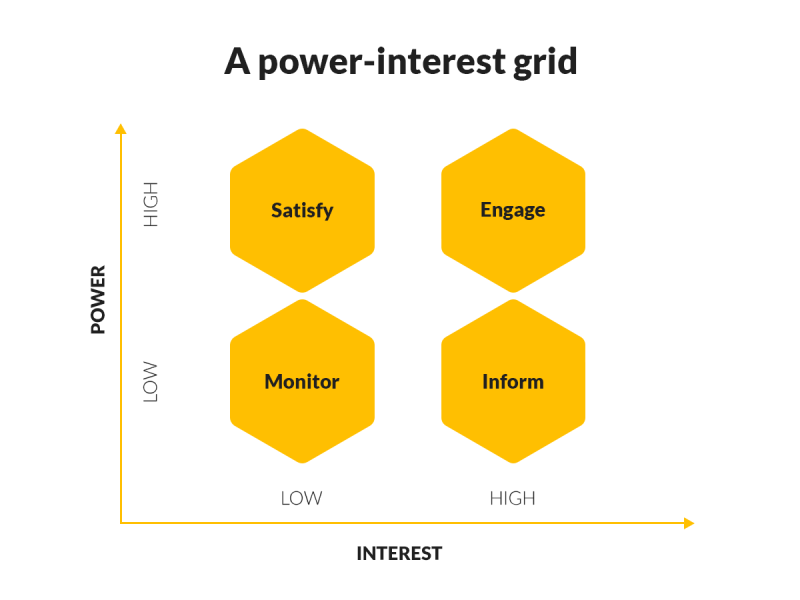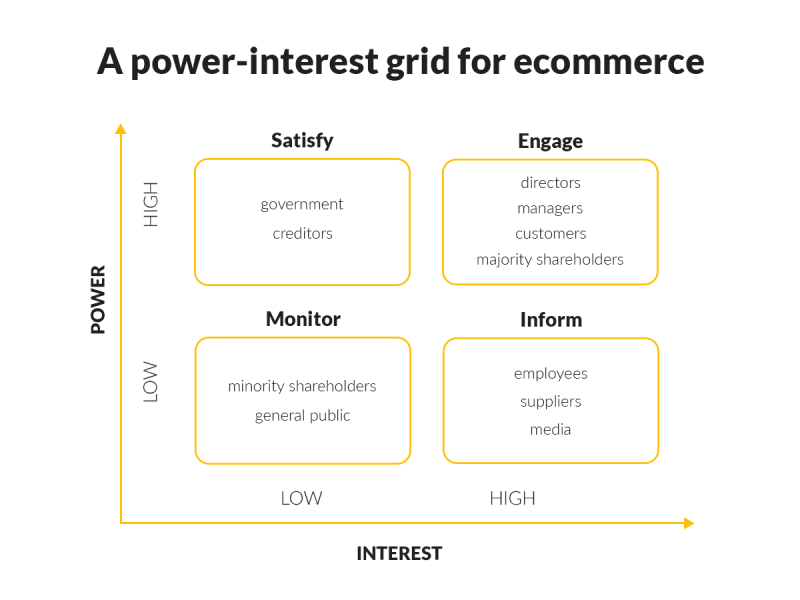Businesses are influenced by numerous interest groups, each with their own set of expectations and needs. These groups can directly or indirectly affect the company’s operations, making it crucial to consider their perspectives when taking strategic decisions. One effective tool for identifying and analyzing these groups is a stakeholder map, also known as a stakeholder analysis. By creating a visual representation of stakeholders and their relationships with the company, businesses can gain insights into each group’s character and importance. In the following article, you will get a better understanding of how stakeholder mapping works and how it can benefit your business.
What is a stakeholder map? – table of contents:
- What is a stakeholder map?
- Types of stakeholders
- Stakeholders vs shareholders
- When to use a stakeholder map?
- How to create a stakeholder map?
- The benefits of stakeholder mapping
- Example of a stakeholder map
- Summary
What is a stakeholder map?
Stakeholders can be defined as individuals or groups of people whose level of engagement can impact your company’s operations or the success of the project. They may provide funds for business activities or express opinions about your services and products through reviews, recommendations, referrals, and more.
Developing strong relationships with stakeholders is crucial for any business to achieve its strategic goals. That’s why it’s so important for a business owner to know their stakeholders and be able to define their role. Stakeholder mapping can help with this. It is a tool most commonly presented in the form of a matrix or mind map that indicates the contribution to the future of the company of each group of interested parties.

Types of stakeholders
Stakeholders can be categorized in several ways:
- External stakeholders – these are individuals or entities that have an impact on the final shape of a product or service, but don’t participate directly in its creation. For example, creditors, suppliers, and social groups.
- Internal stakeholders – these are people or entities who are involved to varying degrees in creating an offer and have an impact on the outcomes. They may include, for example, company management, employees, or trade unions.
- Primary stakeholders – these are individuals or entities who have an active role in carrying out the project and whose actions can affect its success.
- Secondary stakeholders – these are people or entities who may not have a direct connection with the company, but still have an influence on the company’s actions and decisions.
- Direct stakeholders – these are individuals who are deeply involved in the project as its results have a significant impact on them personally. They may include, for instance, managers, investors and employees.
- Indirect stakeholders – they concentrate on the results rather than on the implementation stage, e.g. customers.
Stakeholders vs shareholders
What is the difference between stakeholders and shareholders? As we’ve mentioned before, stakeholders can interfere in a company’s operations and policies, as well as deal with non-financial factors affecting its performance. The key issue for them is to have a successful company. Shareholders, in turn, focus mainly on the financial aspect and profitability of the organization as they own shares in it and seek a return on their investment.
When to use a stakeholder map?
It’s worthwhile to conduct a stakeholder analysis especially if you want to carry out a large project. This will help you build engagement with particular groups. You can use this tool when:
Starting a project
The success of a new initiative in a company heavily relies on the attitudes and engagement of its management and employees.
Launching a new product
Many different groups can be involved in the process of creating a new product, such as:
- Investors – in certain business ventures, significant capital investments are necessary, which may be beyond your own means. In such a case, seeking investment from external sources becomes a viable option.However, it’s essential to keep in mind that investors who provide funding for a project will typically gain the power to influence certain decisions related to its development and management.
- Customers– understanding your customers’ needs is extremely important. Tailoring your product and communication will earn their loyalty, increase sales, and ultimately boost your company’s profits.
- Competitors – it’s advisable to keep an eye on what your competitors are doing and watch industry trends to be able to respond promptly and reinforce your market position when needed.
Penetrating the market
When looking to enter new markets, you will need to decide which stakeholders will be the most important to you:
- Suppliers – without developing relationships with new contractors, your efforts may not be enough to meet the goals you’ve set.
- Customers – think about what problems your potential customers may have and how you can solve them. Also, don’t forget about the customers you’ve already acquired and try to build a lasting relationship with them.
How to create a stakeholder map?
- Brainstorm to identify all stakeholders.
- Group stakeholders based on their level of involvement and consider factors that may affect their attitudes.
- Set priorities and goals for each stakeholder.
- Categorize stakeholders into relevant groups:
High power, low interest – SATISFY
In the case of groups with high power and low interest, you should answer their questions, dispel their doubts, and make sure their needs are being met.
High power, high interest – ENGAGE
You should work closely with stakeholders who show high interest and have a great impact on the success of the project. You ought to offer them as many opportunities as possible to share their opinions, hold meetings, and test products.
Low power, low interest – MONITOR
Although it’s important to pay attention to groups with low power and interest, as well as keep them informed about the progress of work, they don’t require close supervision and dynamic actions.
Low power, high interest – INFORM
When dealing with stakeholders who are highly engaged, but have low influence, it’s still important to keep them informed about the project progress and initiatives. One way to do this is through regular email updates. Also, it’s important to be responsive and offer information and advice when they request it.

The benefits of stakeholder mapping
Developing a successful stakeholder engagement strategy
Creating a stakeholder map will help you to establish and maintain strong relationships with stakeholders.
Understanding your stakeholders’ goals
In this way, you’ll be able to tailor your communications to a specific group of stakeholders, which will boost their engagement.
Making a better use of your resources
Understanding the stakeholders’ power and their level of interest will let you allocate the appropriate financial resources and time needed for the project more accurately.
Identifying potential conflicts
Different stakeholder groups may have varying interests, which can lead to communication problems. By analyzing the position and expectations of each entity, you will be able to avoid potential conflicts and offer solutions that will ease the tension.
Enhancing your chances of success
Stakeholder mapping will let you increase your stakeholders’ engagement, which is crucial if you want to achieve your strategic goals.
Example of a stakeholder map
It’s important to remember that depending on the size and type of business, there may be various interest groups and you may have different relationships with them. In the case of the ecommerce industry, we can speak of the following stakeholders:
Banks, creditors etc. 4
Creditors are entities that provide loans, and the company has financial obligations to them. Receivables are repaid from the sale of products and services.
Government
Your business must comply with the prevailing laws. Remember that the authorities may have the influence to change particular regulations. You must pay your taxes, follow the rules of fair trade and run your company respecting the consumers’ interests. Otherwise, you may be exposed to legal liability.
General public
Your image plays a decisive role in building trust among potential customers and shareholders. It’s worth embracing corporate social responsibility (CSR) and learning what attitudes the public expects from you.
Media
Every enterprise must use various mass media to mark its presence in the market. This is especially important in the ecommerce industry.
Customers
Customers are the buyers of your products. Without them, your business wouldn’t survive in the market. It is your company’s job to identify and then solve their problems. Their feedback lets you constantly improve your processes. Loyal customers are an added value that needs to be taken care of through high-quality services, customer support and efficient communication.
Suppliers
Suppliers are responsible for selling goods and are financially dependent on you. The quality of the products they deliver can affect your company’s operations.
Directors, managers
Directors and managers have a direct impact on your company by overseeing work, managing relationships with stakeholders, and more.
Employees
Employees play a vital role in the success of any organization. Their satisfaction has a direct impact on the quality of their work and the level of customer service they provide. For this reason, it is crucial to offer them good working conditions, opportunities for professional growth, and a motivational system.
Shareholders
Depending on the amount of money invested in a company, stakeholders take different positions. The main shareholders, who contribute the most capital to the company’s resources, have a decisive influence on the direction and manner of its operations, as well as access to financial reports.

Summary
Creating a stakeholder map can provide an overview of the individuals and groups involved in your business, and understanding their needs is crucial to achieving strategic goals and success in the long term.
Read also: The Delphi technique and its use in strategic management.
If you like our content, join our busy bees community on Facebook, Twitter, LinkedIn, Instagram, YouTube, Pinterest, TikTok.
Author: Robert Whitney
JavaScript expert and instructor who coaches IT departments. His main goal is to up-level team productivity by teaching others how to effectively cooperate while coding.


















